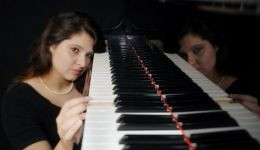Gabrielle L


Instruments: Piano
Styles: Classical


Gabrielle L

Instruments: Piano
Styles:
Classical
Where I Teach:
Ages Taught: 5-80
B.Mus, Salem College, Piano Performance (2009-2010) B.Mus, The University of Michigan School of Music, Theatre & Dance, Music Theory (2011-2013)
State of the Arts Scholarship, FPTA (piano)
2009- Salem College Maude Hawke Full-Tuition Scholarship (piano)
Artist & Scholar Music Honors Program, The University of Michigan: 2012-2014
Seeing and hearing my students succeed is something that brings great joy to my life. I love performing, but teaching and sharing my love of music with others is a special experience. In 2014 I received my Bachelor of Music degree in Music Theory from The University of Michigan School of Music, Theatre & Dance, with Piano as my principal instrument. I am currently studying musicianship at Vanderbilt University and work as a professional pianist/teacher.
I have been teaching piano for 8 years, and have experience teaching children as well as adults. My youngest student was 5 and my oldest 73. My experience has taught me that it is important to be flexible depending on individual students' learning styles and needs. For example, if I have a young student and they don't know how to read music, we will play rhythm clapping games so they can understand how to read rhythm rather than trying to read rhythm and play the rhythms at the piano, simultaneously. Similarly, if an adult student experiences difficulty with rhythm I will have them clap or tap small parts of the rhythm rather than trying to play the entire part at once. The most challenging aspect of teaching is finding what works for each student. This detective work is something I am especially good at.
For all students (beginners and students with prior experience) I begin with teaching scales and arpeggios. Scales and arpeggios are the foundation of keyboard technique, and are found in all piano repertoire the student will encounter. I generally use the Macfarren Scale and Arpeggio Manual for older children/adults (those who read music) or the Scales, Chords, Arpeggios, and Cadences: First Book (Alfred) for children. If my student cannot read music I teach them scales and arpeggios without music, while teaching them how to read music from a method book. For repertoire, I like to use the Faber Piano Adventures series. There is also a Faber Adult Piano Adventures series for adults. My students play scales, learn music, and also learn some music theory so they understand why the music sounds the way it does and how it works.
My approach to teaching music is holistic. I believe there are 3 important components that lead to mastery of the instrument: 1. Technique, 2. Artistry, 3. Comprehension. Technique: Understanding of the body and how it works at the piano. By this, I mean how to play using the weight of the body rather than brute force. Playing the piano does not require strong muscles or physical strength. It requires an intricate and fluid motion that comes from understanding how the hands/arms are connected to the rest of the body, and how they work together to produce sound from the piano. Artistry: This is the creative and emotional aspect of music-making. Being able to express emotion interpreting a piece of music while bearing in mind stylistic paramaters of the given historical period. Comprehension: Being cognizant of the theoretical practices employed in a given composition; knowing what the notes on the page mean in context rather than just reading and playing them.

